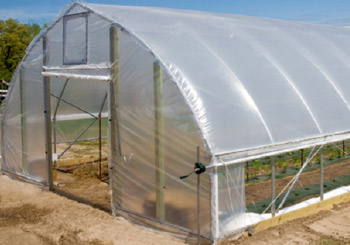High Tunnel Farming
At Ter-Lee Gardens, we have been engaged in high tunnel agricultural production for three decades. We currently have seven high tunnels on our farm.
 While visiting France in the early 1990‘s, on a University of Minnesota Research Project, I was introduced to the high tunnel concept. The French have a love affair with their food; they demand it to be pesticide free as much as possible, have the best flavor possible, have long shelf life, and it should be available for as much of the year as possible. The French believe that healthful food leads to a healthy life, and they are willing to pay extra for high quality food. I believed that these concepts are what we wanted to develop at Ter-Lee Gardens.
While visiting France in the early 1990‘s, on a University of Minnesota Research Project, I was introduced to the high tunnel concept. The French have a love affair with their food; they demand it to be pesticide free as much as possible, have the best flavor possible, have long shelf life, and it should be available for as much of the year as possible. The French believe that healthful food leads to a healthy life, and they are willing to pay extra for high quality food. I believed that these concepts are what we wanted to develop at Ter-Lee Gardens.
While investigating growing-season extension ideas, we noted this technology was making use of simple, low-cost metal framing and lightweight polyethylene covering material to form tunnel- like structures over their crops. These structures protected their crops from the natural elements and extended their growing seasons. Growers noted increases in crop production due to earlier planting dates and increases in the length of their fall harvest season due to the micro-climate created by the tunnel framing and covering. Believing this technology had significant relevance to far northern Minnesota vegetable and fruit crop farming, we began, and continue, to embrace the French and European high tunnel concept. We developed several friends from France and England, who have given us guidance throughout the years.
Gradually, over the years we have conducted intensive research with high tunnels in Northern Minnesota and we’ve come to understand the many benefits of using "high tunnel" technology in the production of our various small fruit and vegetable crops. The basic advantages have been up to six weeks earlier production in the spring, six weeks later in the fall, protection from extreme weather events such as frost, hail, excessive rain and wind, and allowing us to use mostly no pesticides, which allows us to produce more organically grown fruits and vegetables. And all this is done with free solar energy from the sun.
High Tunnel Farming at Ter-Lee Gardens
We use many of the same procedures and land cultivation techniques learned from open field farming; the only difference in high tunnel farming is that we place steel skeletons over the fields and then cover them with removable and recyclable plastic covers, but it is actually a lot more complicated than is sounds.
Before planting, we gently cultivate the soil and place a thin drip irrigation line for each row of vegetables or fruit, to provide water when our crop is planted. Next in this process is the placement of a black plastic mulch to cover the raised bed, which is followed by the planting of our vegetable and/or fruit transplants.
The use of the drip irrigation lines allows us to conserve our water resources by only watering a narrow area alongside of our plants, leaving the aisles dry and unwatered. This is in lieu of traditional irrigation, which wets the entire area of the field/plot and in which 30-50% of the water is lost to evaporation or leaching. By placing the black plastic mulch over the beds and watering only the bed area, we suppress weed growth, conserve our precious water and increase the soil temperature substantially. But when weeds do grow, every square foot of high tunnel area is weeded by hand. We NEVER use herbicides in the tunnels-EVER!
Through the use of our preseason soil amendments(worm castings, compost and manure), and along with drip irrigation and mulch covering, we have constructed a plant-friendly micro-climate. Add to this our placement of beneficial pollinators (bumblebee colonies) within the high tunnel, and it yields a plant friendly environment rivaling the best outside growing areas, but at least several weeks earlier in spring and later in fall.
Over the years we have taught many education sessions on high tunnels locally and around the U.S., and we conduct several tours on our farm every year. In 2004, we wrote the first Minnesota High Tunnel Manual for growers and updated it in 2012, so growers around the area and the United States can benefit from high tunnel production and more healthy food will, ultimately, be available to you, the consumer.
